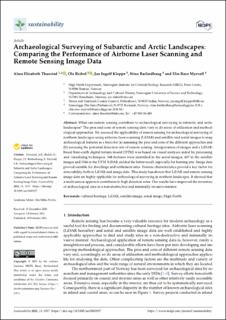| dc.contributor.author | Thuestad, Alma Elizabeth | |
| dc.contributor.author | Risbøl, Ole | |
| dc.contributor.author | Kleppe, Jan Ingolf | |
| dc.contributor.author | Barlindhaug, Stine | |
| dc.contributor.author | Myrvoll, Elin Rose | |
| dc.date.accessioned | 2021-02-24T10:45:23Z | |
| dc.date.available | 2021-02-24T10:45:23Z | |
| dc.date.created | 2021-02-23T07:30:58Z | |
| dc.date.issued | 2021 | |
| dc.identifier.citation | Sustainability. 2021, 13 (4), . | en_US |
| dc.identifier.issn | 2071-1050 | |
| dc.identifier.uri | https://hdl.handle.net/11250/2730025 | |
| dc.description.abstract | What can remote sensing contribute to archaeological surveying in subarctic and arctic landscapes? The pros and cons of remote sensing data vary as do areas of utilization and methodological ap-proaches. We assessed the applicability of remote sensing for archaeological surveying of northern landscapes using airborne laser scanning (LiDAR) and satellite and aerial images to map archae-ological features as a basis for a) assessing the pros and cons of the different approaches and b) assessing the potential detection rate of remote sensing. Interpretation of images and a LiDAR-based bare-earth digital terrain model (DTM) was based on visual analyses aided by processing and visualizing techniques. 368 features were identified in the aerial images, 437 in the satellite images and 1186 in the DTM. LiDAR yielded the better result, especially for hunting pits. Image data proved suitable for dwellings and settlement sites. Feature characteristics proved a key factor for detectability, both in LiDAR and image data. This study has shown that LiDAR and remote sensing image data are highly applicable for archaeological surveying in northern landscapes. It showed that a multi-sensor approach contributes to high detection rates. Our results have improved the inventory of archaeological sites in a non-destructive and minimally invasive manner. | en_US |
| dc.language.iso | eng | en_US |
| dc.publisher | MDPI | en_US |
| dc.rights | Navngivelse 4.0 Internasjonal | * |
| dc.rights.uri | http://creativecommons.org/licenses/by/4.0/deed.no | * |
| dc.title | Archaeological Surveying of Subarctic and Arctic Landscapes: Comparing the Performance of Airborne Laser Scanning and Remote Sensing Image Data | en_US |
| dc.type | Peer reviewed | en_US |
| dc.type | Journal article | en_US |
| dc.description.version | publishedVersion | en_US |
| dc.source.pagenumber | 19 | en_US |
| dc.source.volume | 13 | en_US |
| dc.source.journal | Sustainability | en_US |
| dc.source.issue | 4 | en_US |
| dc.identifier.doi | https://doi.org/10.3390/su13041917 | |
| dc.identifier.cristin | 1892591 | |
| dc.relation.project | Norges forskningsråd: 208439 | en_US |
| dc.description.localcode | This is an open access article distributed under the Creative Commons Attribution License which permits unrestricted use, distribution, and reproduction in any medium, provided the original work is properly cited | en_US |
| dc.source.articlenumber | 2017 | en_US |
| cristin.ispublished | true | |
| cristin.fulltext | original | |
| cristin.qualitycode | 1 | |

